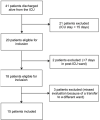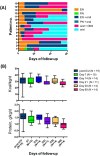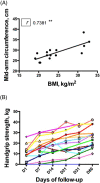Nutrition evaluation and management of critically ill patients with COVID-19 during post-intensive care rehabilitation
- PMID: 33666263
- PMCID: PMC8014266
- DOI: 10.1002/jpen.2101
Nutrition evaluation and management of critically ill patients with COVID-19 during post-intensive care rehabilitation
Abstract
Background: Among hospitalized patients with coronavirus disease 2019 (COVID-19), up to 12% may require intensive care unit (ICU) management. The aim of this prospective cohort study is to assess nutrition status and outcome in patients with COVID-19 following ICU discharge.
Methods: Patients requiring a minimum of 14 days' stay in the ICU with mechanical ventilation were included. Nutrition status was assessed at inclusion (ICU discharge) and follow-up (after 15, 30, and 60 days). All patients had standardized medical nutrition therapy with defined targets regarding energy (30 kcal/kg/d) and protein intake (1.5 g/kg/d).
Results: Fifteen patients were included (67% males); the median age was 60 (33-75) years old. Body mass index at ICU admission was 25.7 (IQR, 24-31) kg/m². After a median ICU stay of 33 (IQR, 26-39) days, malnutrition was present in all patients (11.3% median weight loss and/or low muscle mass based on handgrip strength measurement). Because of postintubation dysphagia in 60% of patients, enteral nutrition was administered (57% nasogastric tube; 43% percutaneous endoscopic gastrostomy). After 2 months, a significant improvement in muscle strength was observed (median handgrip strength, 64.7% [IQR, 51%-73%] of the predicted values for age vs 19% [IQR, 4.8%-28.4%] at ICU discharge [P < 0.0005]), as well as weight gain of 4.3 kg (IQR, 2.7-6.7 kg) (P < 0.0002).
Conclusions: Critically ill patients with COVID-19 requiring ICU admission and mechanical ventilation have malnutrition and low muscle mass at ICU discharge. Nutrition parameters improve during rehabilitation with standardized medical nutrition therapy.
Keywords: SARS-CoV2; malnutrition; medical nutrition therapy; nutrition support.
© 2021 American Society for Parenteral and Enteral Nutrition.
Conflict of interest statement
None declared.
Figures




Similar articles
-
Evolution of the nutritional status of COVID-19 critically-ill patients: A prospective observational study from ICU admission to three months after ICU discharge.Clin Nutr. 2022 Dec;41(12):3026-3031. doi: 10.1016/j.clnu.2021.05.007. Epub 2021 May 24. Clin Nutr. 2022. PMID: 34134915 Free PMC article.
-
Nutritional and Physical Rehabilitation in Post-Critical Coronavirus Disease 2019 (COVID-19) Ambulatory Patients: The NutriEcoMuscle Study.Nutrients. 2025 May 20;17(10):1722. doi: 10.3390/nu17101722. Nutrients. 2025. PMID: 40431462 Free PMC article.
-
Baseline Characteristics and Outcomes of 1591 Patients Infected With SARS-CoV-2 Admitted to ICUs of the Lombardy Region, Italy.JAMA. 2020 Apr 28;323(16):1574-1581. doi: 10.1001/jama.2020.5394. JAMA. 2020. PMID: 32250385 Free PMC article.
-
Effect of a multidisciplinary nutrition management model in patients with critical illness: A randomized trial.Nurs Crit Care. 2024 Mar;29(2):417-426. doi: 10.1111/nicc.12988. Epub 2023 Nov 7. Nurs Crit Care. 2024. PMID: 37935453 Review.
-
Medical nutrition therapy for patients with malnutrition post-intensive care unit discharge: A case report of recovery from coronavirus disease 2019 (COVID-19).Nutr Clin Pract. 2021 Aug;36(4):820-827. doi: 10.1002/ncp.10728. Epub 2021 Jul 10. Nutr Clin Pract. 2021. PMID: 34245599 Free PMC article. Review.
Cited by
-
Energy Requirements in the Post-ICU Period: An Exploratory Multicenter Observational Study.Nutrients. 2025 Jun 19;17(12):2046. doi: 10.3390/nu17122046. Nutrients. 2025. PMID: 40573156 Free PMC article.
-
Expert consensus‑based clinical practice guidelines for nutritional support in the intensive care unit: the French Intensive Care Society (SRLF) and the French-Speaking Group of Pediatric Emergency Physicians and Intensivists (GFRUP).Ann Intensive Care. 2025 Jul 15;15(1):99. doi: 10.1186/s13613-025-01509-0. Ann Intensive Care. 2025. PMID: 40665004 Free PMC article. Review.
-
Nutrition support practices across the care continuum in a single centre critical care unit during the first surge of the COVID-19 pandemic - A comparison of VV-ECMO and non-ECMO patients.Clin Nutr. 2022 Dec;41(12):2887-2894. doi: 10.1016/j.clnu.2022.08.027. Epub 2022 Sep 10. Clin Nutr. 2022. PMID: 36216665 Free PMC article.
-
Functional Recovery and Nutrition Management among Severe COVID-19 Cases during Post-extubation Hospitalization: A Case Series.Prog Rehabil Med. 2023 Jul 12;8:20230020. doi: 10.2490/prm.20230020. eCollection 2023. Prog Rehabil Med. 2023. PMID: 37440788 Free PMC article.
-
Evidence-based position paper on physical and rehabilitation medicine professional practice for persons with COVID-19, including post COVID-19 condition: the European PRM position (UEMS PRM Section).Eur J Phys Rehabil Med. 2023 Dec;59(6):789-799. doi: 10.23736/S1973-9087.23.08315-6. Eur J Phys Rehabil Med. 2023. PMID: 38214046 Free PMC article.
References
-
- Puthucheary ZA, Rawal J, Mcphail M, et al. Acute skeletal muscle wasting in critical illness. JAMA. 2013;310(15):1591‐1600. - PubMed
-
- AD . Leblanc R, Pientok C, Rowe R. Regional changes in muscle mass following I7 weeks of bed rest. J Appl Physiol. 2018;73(5):2172‐2178. - PubMed
-
- Gomes F, Schuetz P, Bounoure L, et al. ESPEN guidelines on nutritional support for polymorbid internal medicine patients. Clin Nutr. 2018;37(1):336‐353. - PubMed
MeSH terms
LinkOut - more resources
Full Text Sources
Other Literature Sources
Medical
Miscellaneous

